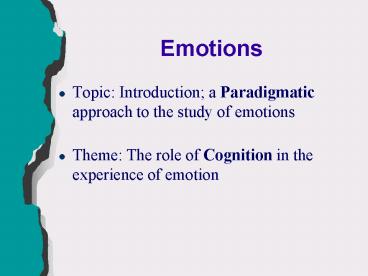Emotions PowerPoint PPT Presentation
1 / 18
Title: Emotions
1
Emotions
- Topic Introduction a Paradigmatic approach to
the study of emotions - Theme The role of Cognition in the experience of
emotion
2
Step 1 The beginning James-Lange (1880s)
- A sequential theory
- First group to explore emotions scientifically
- Stimulus--gt physiological change---gt awareness of
change... - that awareness is the emotion
3
James-Lange Theory
4
James-Lange Theory
- Perception of event See a bear
5
James-Lange Theory
- Perception of Event See a Bear
- Bodily Expression Run
6
James-Lange Theory
- Perception of Event See a Bear
- Bodily Expression Run
- Subjective Experience Become Afraid
Oh-oooooh!
7
James-Lange Theory
- Sensory Input Cortex
- 1
- 2
3 - Bodily Expression Muscles Viscera
- Subjective Experience - Feedback to Cortex -
emphasis on unique patterns of physiological
feedback - Emotions - Perceptions of Bodily Changes
8
- Criticism Emotions are experienced too quickly
for sequence to work
9
- See Dragon...
- Experience arousal
- RUN (too late)
10
Step 2 A Modification Cannon-Bard (1920s)
- A simultaneous theory
-
physiological reaction - Stimulus
- cognitive
awareness - Physiological reaction?
- activation of sympathetic nervous system
- symptoms (what are they?)
11
Cannon-Bard Thalamic Theory
- Perception of Event
- See a Bear
- Become afraid Run
- Subjective Experience Bodily Expression
- Physiological changes in the body are
- correlates of the emotional state
12
Step 3 Cognitive Involvement Schachter Singer
(1960s)
- A 2-factor theory
- physiological arousal the label (cognition)
emotion - label result of experience and environmental
cues - their experiment Arousing stimulus placebo
false information social cue (from
actor)---gtincorrect label of emotion
13
(No Transcript)
14
Step 3a Valins (1966)
- Is physiological arousal necessary?
- Experiment False feedback on arousal
attractive stimuli - DV evaluation of 10 slides of nude women (male
Ss) - Cognition ---gt emotion (without arousal )
15
Step 4 Excitation Transfer Zillman (1970s
1980s)
- Response to multiple arousing stimuli?
- Cognitive Awareness of stimulus one (S1) arousal
dissipates (diminishes) faster than physiological
arousal actually caused by it - Timing of arousing stimulus two (S2) relative to
S1 important (why?) - Transfer (summation) overreaction to S2 due to
residual arousal from S1
16
(No Transcript)
17
Step 5 Motivational Biases? Gibbons Wright
(1980s)
- Can people decide to/not to experience an
emotion? - Cognitive choice between arousing stimuli
- One stimulus is unacceptable the other is OK
18
- Experiment disposition sexual attitudes
(conservatism), plus placebo (drug) - 2 potential sources of arousal (ambiguity) ---gt
causal attribution (what caused my arousal?) - choice affects emotional state
- choice also protects ego

